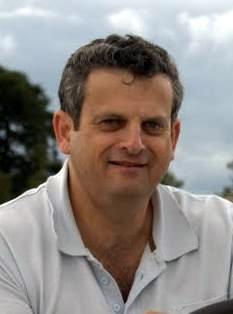Title: Some New Analytical Tools for Evaluation of Code Ensemble Performance
Neri Merhav, Technion

In this talk, I will give an overview of several new analytical tools, that I have gradually developed during the last decade, for assessing the performance of code ensembles in a variety of scenarios of coded communication configurations. By bypassing the traditional use of certain well-known inequalities, such as Jensen's inequality and others, these analytical tools often enable exponentially-tight evaluations of the average error probability, the excess distortion probability, and other types of large deviations probabilities. These tools were inspired by models and methods of statistical physics. In particular, the first tool that I will describe, which I will refer to as "type-class enumeration method", was inspired by the so-called random energy model (REM) of spin glasses in statistical mechanics, as there is a remarkable degree of similarity and parallelism between the REM and the paradigm of random coding. The second tool is a continuous-alphabet analogue of the method of types, without recourse to non-elegant quantization arguments that convert the problem back to the realm of finite alphabets. In this context, one of the powerful techniques is saddle-point integration. The results obtained from these tools will be demonstrated in a variety of examples. Finally, time permits, I will also discuss additional techniques, like integral representations of the logarithmic function and non-integer power functions, with applications to information theory, as well as methods for reversing Jensen's inequality.
Neri Merhav (S'86-M'87-SM'93-F'99) was born in Haifa, Israel, on March 16, 1957. He received the B.Sc., M.Sc., and D.Sc. degrees from the Technion, Israel Institute of Technology, in 1982, 1985, and 1988, respectively, all in electrical engineering. From 1988 to 1990 he was with AT&T Bell Laboratories, Murray Hill, NJ, USA. Since 1990 he has been with the Electrical Engineering Department of the Technion, where he is now the Irving Shepard Professor. During 1994-2000 he was also serving as a consultant to the Hewlett-Packard Laboratories - Israel (HPL-I). His research interests include information theory, statistical communications, and statistical signal processing. He is especially interested in the areas of lossless/lossy source coding and prediction/filtering, relationships between information theory and statistics, detection, estimation, as well as in the area of Shannon Theory, including topics in joint source-channel coding, source/channel simulation, and coding with side information with applications to information hiding and watermarking systems. Another recent research interest concerns the relationships between Information Theory and statistical physics. Dr. Merhav was a co-recipient of the 1993 Paper Award of the IEEE Information Theory Society and he is a Fellow of the IEEE since 1999. He also received the 1994 American Technion Society Award for Academic Excellence and the 2002 Technion Henry Taub Prize for Excellence in Research. More recently, he was a co-recipient of the Best Paper Award of the 2015 IEEEWorkshop on Information Forensics and Security (WIFS 2015). During 1996-1999 he served as an Associate Editor for Source Coding to the IEEE Transactions on Information Theory, and during 2017-2020 - as an Associate Editor for Shannon Theory in the same journal. He also served as a co-chairman of the Program Committee of the 2001 IEEE International Symposium on Information Theory. He is currently on the Editorial Board of Foundations and Trends in Communications and Information Theory.
Title: My Journey to Explore Codes for Correcting Lee-Metric Errors on 2-D Lattices
Hiroyoshi Morita, The University of Electro-Communications

Now 30 years ago, I heard from one of my best colleagues and best friends, Dr. Han Vinck, now at the University of Duisburg-Essen (then University of Essen), about integer codes on integer remainder rings for correcting phase shift errors. Since then, our research group has mainly studied integer codes for correcting neighborhood errors on two-dimensional square lattices and their application to coded modulation. On the other hand, I had been aware of the close relationship between integer codes and Lee error-correcting codes since I started to research integer codes, but for a long time, I could not find any clues linking the two. Nevertheless, as I continued my search for the results of the pioneers, three papers, in particular, caught my attention. The first is by S. Nishimura and T. Hiramatsu, published in 2008. They present a code's construction and decoding algorithm of a code for correcting double Lee-metric error on a two-dimensional square lattice. The second is by Klaus Huber in 1994. In the paper, he proposes codes over Eisenstein or Eisenstein-Jacobi integers which form a hexagonal lattice on the 2-D lattice. These two papers inspired me to derive a double-Lee-error-correcting code on a two-dimensional hexagonal lattice and its decoding algorithm, and I presented the results at ISIT2019.
After reading my ISIT2019 paper, Dr. Sakata invited me to collaborate with him. According to him, the decoding method I presented at ISIT2019 is essentially the same as the Buchberger algorithm for finding the Groebner basis of ideals of multivariate polynomials; the Buchberger algorithm can help correct more multiple 2-D Lee errors. He is known as the founder of the Berlekamp-Massey-Sakata decoding algorithm for algebraic geometric curve codes. Moreover, he was once my boss and is still one of my best friends. I had no reason to refuse his offer and was more than happy to do so. Then the three of us, Dr. Sakata, his young colleague Dr. Fujisawa, and I began our joint research in March 2020, which has continued to this day. Last fall, we presented a part of our research results at ITW2021 in Kanazawa, JAPAN. The full paper was submitted to IEEE Trans. on Information Theory early last month and is now under the peer-review. The paper presents a general and effective algorithm for correcting multiple Lee-metric errors on 1-D and 2-D lattices using the Buchberger algorithm.
In my talk, I will start constructing linear codes over odd prime fields for correcting two-dimensional Lee-metric errors on the square and hexagonal signal constellations. They are obtained by puncturing and enlarging either Reed-Solomon codes or Bose-Chaudhuri-Hocquenghem codes. Then, I will introduce the basic ideas of solving a system of equations of multivariate polynomials with a brief introduction of ideals, Gröbner bases, and the Buchberger algorithm. Finally, using a few examples, I present the proposed decoding algorithm for finding the error values and locations from 'value-locators' obtained by solving a system of nonlinear algebraic equations using the Buchberger algorithm. The concept of value-locator introduced implicitly by K. Nakamura in 1979 and inherited in the ISIT2019 paper is a key to effective decoding because we cannot separate the error values and locations in decoding error-correcting Lee-metric codes.
Hiroyoshi Morita is a professor emeritus at the University of Electro-Communications in Tokyo, Japan. He received his bachelor's, master and doctorate degrees in engineering from Osaka University, Osaka, Japan, in 1978, 1980, and 1983, respectively. In 1983, he joined Toyohashi University of Technology, Aichi, Japan as a research associate in the school of production system engineering. In 1990, he joined the University of Electro-Communications, Tokyo, Japan, as an assistant professor in the department of computer science and information mathematics. From 1992, he was an associate professor. From 1995, he was with the Graduate School of Information Systems, where from 2005, he was a professor. Since 2017, he has been with the graduate school of informatics and engineering at the university of electro-communications. He was a visiting fellow at the institute of experimental mathematics, the University of Essen in Essen, Germany, during 1993–1994. He served as the Chair of IEEE Information Theory Society Japan Chapter in 2008-2009, the General Co-Chair of the ISITA2014, and the president of the SITA (Society of Information Theory and its Applications) in 2013 and 2014. His research interests mainly include source coding techniques and 2D error correcting codes. He is a senior member of IEICE and an IEEE life senior.